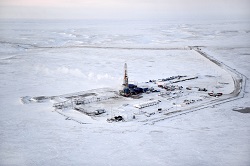- Home page /
- News /
- Company news /
- Gazprom Neft undertakes 20-stage fracking operations first...
Gazprom Neft undertakes 20-stage fracking operations first ever in the Yamal Peninsula
 |
| Courtesy of gazprom-neft.com |
Gazpromneft-Yamal, a subsidiary of Gazprom Neft, has successfully completed 20-stage hydraulic fracking operations at its Novoportovskoye field, using “non-ball and socket” (Mongoose) technology — a method first used in developing hydrocarbon reserves on the Yamal Peninsula and based on the use of rapid-shift sleeves, allowing the opening and closing of individual frac ports. Such a system allows either individual fissures to be closed during well operation in order to prevent the ingress of water, or the closure of all fissures simultaneously, allowing subsequent multistage fracking.
Multistage fracking operations at two wells at the Novoportovskoye field have been undertaken by specialists from Gazpromneft-Yamal, with the support of the Gazprom Neft Science and Research Centre. The initial daily flow rate from a single well is 188 tonnes of oil. The second well is due to be commissioned shortly.
Vadim Yakovlev, First Deputy CEO, Gazprom Neft, commented: "Using the latest technologies in well construction and operation is allowing Gazprom Neft to bring new hydrocarbon reserves into development, meaning we can improve efficiency throughout the entire business. The successful testing of new technology using non-ball and socket (Mongoose) technology on Jurassic deposits at the Novoportovskoye field is further confirmation of our company’s openness to innovation and a further landmark in the development of a strategically important asset for us.
The Novoportovskoye field is one of the most significant oil and gas condensate fields currently under development in the Yamalo-Nenets Autonomous Okrug. Recoverable C1 and C2 reserves are estimated at more than 250 million tonnes of crude and condensate, as well as more than 320 billion cubic metres of gas (including Palaeozoic deposits). The field is located in the south—east of the Yamal Peninsula, some 250 kilometres north of Nadym, and 30 kilometres from the coast of the Gulf of Ob.
Oil from the field is currently transported to the coast through a pressure-pipeline running to more than 100 kilometres in length. Infrastructure established at the field and on the shores of the Gulf of Ob allows the transhipment of up to 8.5 million tonnes of oil per year. The year-round shipment of crude is ensured through the Arctic Gates crude-oil loading terminal — the only such terminal in the world located in a freshwater zone of the Arctic Circle.
Source: gazprom-neft.com

